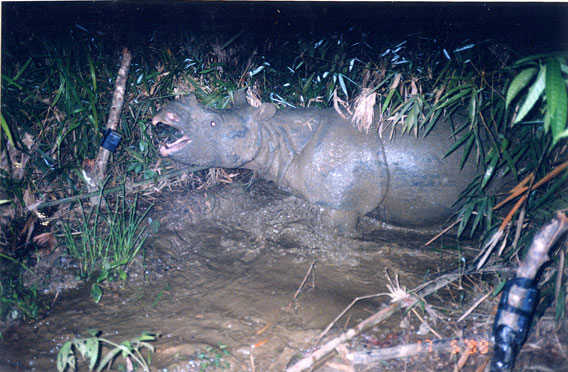
Camera trap catches one of the world’s last Vietnamese rhinos before its killing for the rhino horn trade. Photo courtesy of WWF.
In 2009 poachers shot and killed the world’s last Vietnamese rhinoceros (Rhinoceros sondaicus annamiticus), a subspecies of the Javan rhino. The Vietnamese rhino was the last rhino species that survived on the southeast Asia mainland.
Once roaming much of Southeast Asia—from Vietnam to the east, Thailand to the west, and Malaysia to the south—the Vietnamese rhino was initially thought extinct after the Vietnam war due to the proliferation of guns, but a single population of the Vietnamese was rediscovered in 1988.
The demise of the last rhino was brought about by a bullet, probably for the rhino horn trade. Rhinos are illegally killed for their horns, which are ground into traditional medicines used throughout eastern Asia, primarily in China and, more recently, Vietnam.

Vietnamese rhino. Photo courtesy of WWF.
Though numerous scientific studies have shown that there are no medicinal benefits to consuming rhino horn—made mostly out of keratin, it’s the nutritional equivalent of eating one’s fingernails and hair—rhino poaching has hit new heights recently. In South Africa alone, 333 rhinos were killed by poachers last year to feed the black market demand in Asia.
Beyond poaching, the Vietnamese rhino also suffered from large-scale habitat loss, agricultural encroachment, and the inability of Vietnam to protect the last individuals even in one of its most famous parks.
Now that the Vietnamese subspecies is gone, conservation focus will presumably turn to the Javan rhino population in Ujung Kulon National Park. There are no Javan rhinos in captivity.
Across Asia and Africa, the same pressures—habitat destruction and poaching—have pushed all five of the world’s rhino species, at one time or another, into endangerment. Three of the five species—the black, the Javan, and the Sumatran—are listed as Critically Endangered.
.568.jpg)
Vietnamese rhino. Photo courtesy of WWF.
Related articles

Vietnamese rhino goes extinct
(10/25/2011) In 2009 poachers shot and killed the world’s last Vietnamese rhinoceros (Rhinoceros sondaicus annamiticus), a subspecies of the Javan rhino, confirms a report from International Rhino Foundation (IRF) and the World Wide Fund for Nature (WWF). The Vietnamese rhino was the last Javan rhino to survive on the Asian mainland and the second subspecies to vanish, following the extinction of the Indian Javan rhino (rhinoceros sondaicus inermis). The Javan rhino is the world’s most imperiled rhino species with now only around 50 individuals surviving in a single park on its namesake island in Indonesia.
Belief and butchery: how lies and organized crime are pushing rhinos to extinction

(05/11/2011) Few animals face as violent, as well organized, and as determined an enemy as the world’s rhinos. Across the globe rhinos are being slaughtered in record numbers; on average more than one rhino is killed by poachers everyday. After being shot or drugged, criminals take what they came for: they saw off the animal’s horn. Used in Traditional Chinese Medicine, which claims that it has curative properties, rhino horn is worth more than gold and cocaine on the black market. However, science proves all this cash and death is based on a lie. ‘There is no medicinal benefit to consuming rhino horn. It has been extensively analyzed in separate studies, by different institutions, and rhino horn was found to contain no medical properties whatsoever,’ says Rhishja Larson.
Face-to-face with what may be the last of the world’s smallest rhino, the Bornean rhinoceros

(12/01/2009) Nothing can really prepare a person for coming face-to-face with what may be the last of a species. I had known for a week that I would be fortunate enough to meet Tam. I’d heard stories of his gentle demeanor, discussed his current situation with experts, and read everything I could find about this surprising individual. But still, walking up to the pen where Tam stood contentedly pulling leaves from the hands of a local ranger, hearing him snort and whistle, watching as he rattled the bars with his blunted horn, I felt like I was walking into a place I wasn’t meant to be. As though I was treading on his, Tam’s space: entering into a cool deep forest where mud wallows and shadows still linger. This was Tam’s world; or at least it should be.













